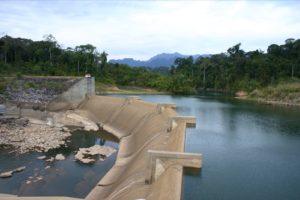Laos Mekong Dam Proposal Creates Friction
 The latest effort in Laos to build the Pak Beng dam on the Mekong River mainstream presents the latest test for cooperation in Southeast Asia. Many fear that the Pak Beng dam will further damage the fragile environment and ecosystem that over 60 million people depend on for sustenance. The proposed 912 megawatt dam in the northern province of Oudomxay marks Vientiane’s latest move in its attempt to make the impoverished country the “battery of Asia” through the construction of a series of hydroelectric dams along the Mekong River and its tributaries.
The latest effort in Laos to build the Pak Beng dam on the Mekong River mainstream presents the latest test for cooperation in Southeast Asia. Many fear that the Pak Beng dam will further damage the fragile environment and ecosystem that over 60 million people depend on for sustenance. The proposed 912 megawatt dam in the northern province of Oudomxay marks Vientiane’s latest move in its attempt to make the impoverished country the “battery of Asia” through the construction of a series of hydroelectric dams along the Mekong River and its tributaries.
Laos notified the Mekong River Commission (MRC), an intergovernmental organization with representatives from Laos, Cambodia, Vietnam, and Thailand, of its plans for the dam in November. Laos started building its two previous dams in 2012 and 2014 despite objections from other countries and from scientists and conservationists. The MRC’s international donors cut their funding to express their frustration over what they saw as the commission’s complicity in Laos’ pursuit of an energy strategy that “causes harm to its neighbors.”
The MRC was initially established as a platform for regional cooperation in 1995, when Cambodia, Laos, Thailand, and Vietnam signed the Agreement on Cooperation for Sustainable Development of the Mekong River Basin. The estimated potential energy from harnessing the lower Mekong River’s hydropower through the agreement is over 30,000 MW, while just over 3,000 MW which has been utilized. Projects totalling nearly 4,000 MW, including the two existing Laos dams, are currently still under construction. However, the economic and environmental impacts of dams are large. The quantity of fish in the river is expected to decrease by 500,000 to 800,000 tons, a negative impact to both biodiversity and the fishing communities living along the river. However, Daovang Phonekeo, director of the project, sidestepped the issue and argued that “the objective of this project is to use hydropower resources to generate electricity to meet domestic demand and export.”
In response to the government’s statements, the environmental NGO International Rivers countered in a press release, “By allowing regional consultation to begin over the Pak Beng dam before addressing outstanding concerns around decision-making on Mekong dams, the MRC risks history repeating itself at the expense of the Mekong River and regional cooperation.” The NGO posits that the MRC’s prior consultation process does not take into account the full effect that projects like the Pak Beng dam have on communities that depend on the river, many of which are agriculture-based and highly impoverished. The government’s consultation process was also criticized for lacking clear requirements in ensuring the meaningful participation of affected communities and the public. “There is little transparency as to how [the public’s] concerns are addressed and factored into decision-making,” International Rivers further stated.
Meanwhile, MRC Secretariat Pham Tuan Phan argues that the commission would be ready to address the public’s concerns regarding the effect of the dam’s construction on the environment and surrounding communities. “We have learned lessons from the previous two cases,” he said. “The Secretariat is ready to assist the member countries to review the project, assess technical aspects, and come to a conclusion in an inclusive and meaningful way." A high-ranking MRC official defended the commission, emphasizing that the MRC is obligated to follow the mandate given to it by the member countries. The official explained, “The MRC is not weak, but it just works under the 1995 agreement.”
